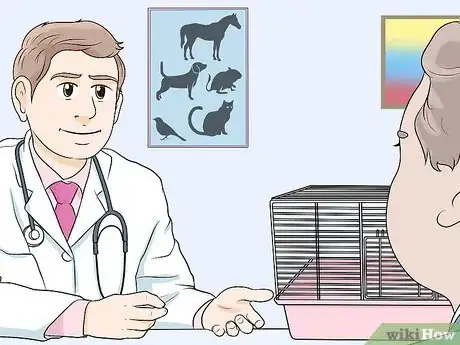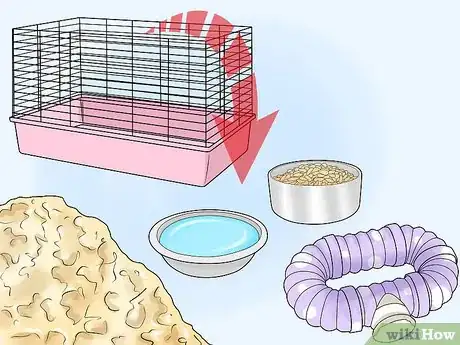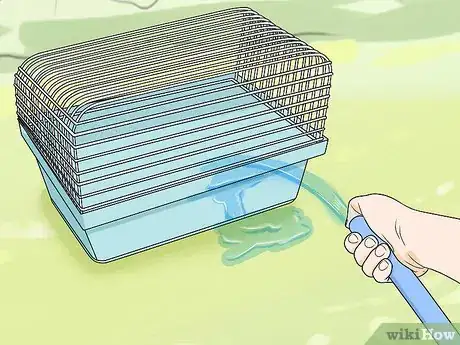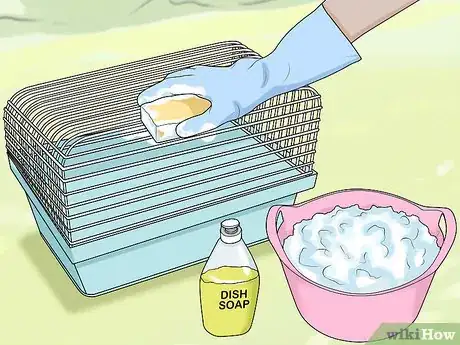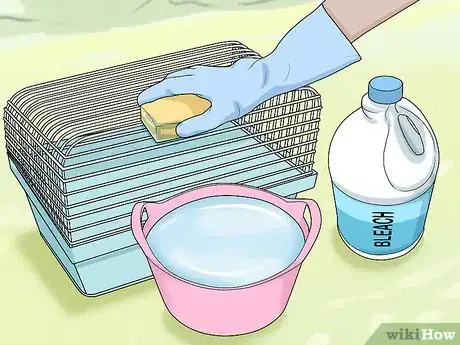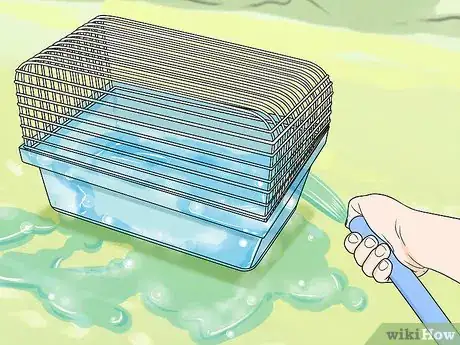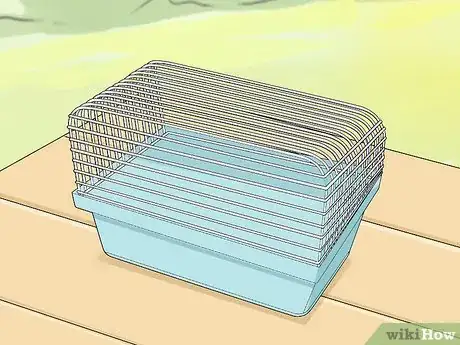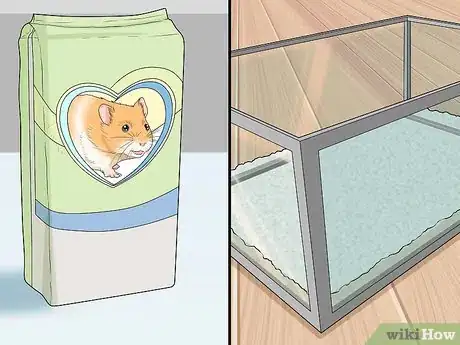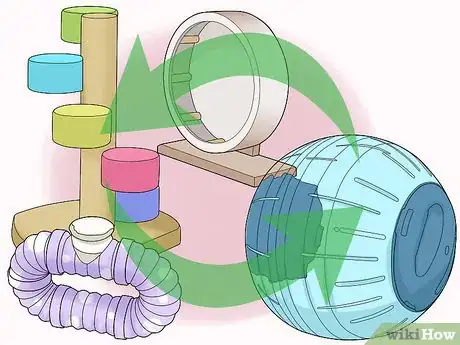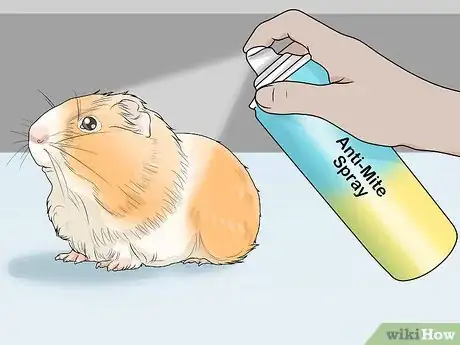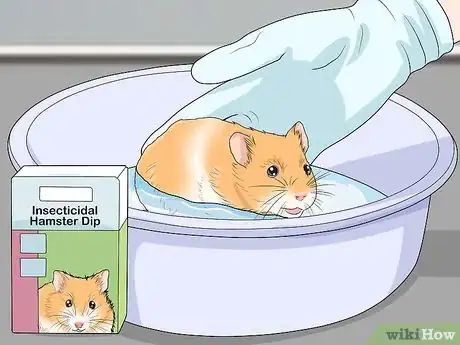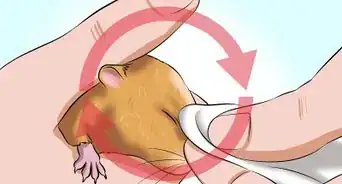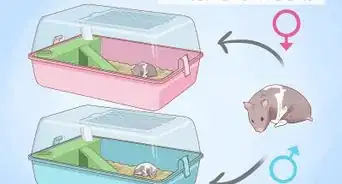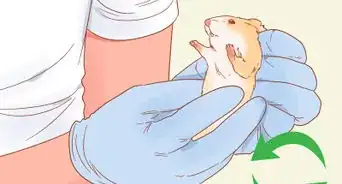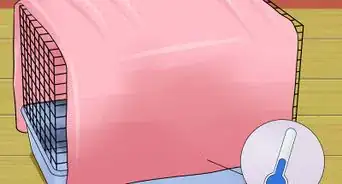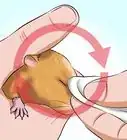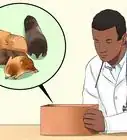This article was co-authored by Pippa Elliott, MRCVS. Dr. Elliott, BVMS, MRCVS is a veterinarian with over 30 years of experience in veterinary surgery and companion animal practice. She graduated from the University of Glasgow in 1987 with a degree in veterinary medicine and surgery. She has worked at the same animal clinic in her hometown for over 20 years.
There are 8 references cited in this article, which can be found at the bottom of the page.
This article has been viewed 68,608 times.
Yikes, your hamster has mites! It is important to treat a mite infestation right away since it can lead to more serious problems like mange. Don't worry, though, because, with the proper care and medication, you can rid your hamster of mites in no time. For mild infestations, use over-the-counter anti-mite sprays. For more severe infestations, your vet may prescribe a medicated spray or an oral medication.
Steps
Diagnosing Your Hamster
-
1Identify the symptoms. Redness around the eyes, nose, and ears could indicate a mild mite infestation. Constant itching is another common symptom of a mild to moderate infestation.[1]
- Hair loss and/or red patches on the skin are symptoms of a more serious infestation.
-
2Take your hamster to the vet. You will not be able to see the mites just by looking at them. Instead, take your hamster to the vet for testing. The vet will take a skin sample by scraping the skin. They will then examine the sample under a microscope. This will confirm that your hamster has mites and, if so, what type.[2]Advertisement
-
3Ask the vet if there are any other underlying conditions. Hamsters are often born with a few mites, but they are able to keep the mites under control. Stress, illness, and other underlying causes can cause the hamster to lose their natural protection against mites. Ask your vet if there is anything you can do to help reduce your hamster's stress.[3]
- Fortunately, these mites are not very contagious. Your other hamsters may be fine.
Cleaning and Disinfecting the Cage
-
1Empty the cage of its bedding and accessories. Place your hamster in a separate cage with fresh bedding and some water. Remove the water and food bowls. Remove any accessories like tunnels, toys, and housing. Throw away the bedding.[4]
- You will also need to clean and disinfect the temporary cage once you put your hamster back into the original cage.
-
2Rinse the cage with water. Bring the cage outside. Spray it down with a hose. Make sure the cage is completely rinsed of any and all dirt and debris.[5]
- Alternatively, use a bucket to pour water over the cage if you don’t have a hose.
-
3Scrub the cage with a soapy solution. Mix a tablespoon (15 ml) of dish soap with six cups (1.4 liters) of warm water in a bucket until a soapy solution forms. Dip a sponge or a scrub brush in the solution. Scrub the entire cage until it is completely clean. Then rinse it with water until all the soap and residue are gone.
- If you are cleaning a wire cage, make sure to clean all the bars, including the top, bottom, and side bars.
-
4Rub the cage with a disinfectant. Dilute ¼ cup (59 ml) of bleach with 2 ¼ cups (532 ml) of water in a bowl or bucket. Dip a clean sponge in the mixture. Rub the entire cage with the disinfectant, focusing on small, tight areas.[6]
- To protect your hands, wear rubber gloves.
-
5Rinse the cage. After you finish disinfecting the cage, you will need to rinse it thoroughly. Rinse the cage until all the bleach is removed, about four to five rinses. If you can still smell bleach, then keep rinsing until you cannot smell it anymore.[7]
-
6Let the cage air dry. Place the cage outside under a covered area like a porch to air dry. The cage must be completely dry before placing the bedding and accessories back in the cage.[8]
-
7Use properly packaged bedding. Bedding that isn’t packaged properly may contain mites and other parasites. The bedding you use should be packaged and sealed. Additionally, always use fresh bedding after cleaning your hamster’s cage.[9]
- Avoid using bedding that you obtained from outside.
-
8Replace the accessories. Accessories that cannot be thoroughly cleaned and disinfected should be thrown away and replaced. This includes accessories like toys, tunnels, and housing materials.[10]
- These materials may contain mite eggs that can re-infest a clean cage.
Treating the Infestation
-
1Ask your vet for an ivermectin treatment. Your vet might inject the ivermectin. They might also give you drops to apply at home. Apply the drops to the back of the hamster's neck once every 2 weeks for a total of 3 times.[11]
- You can sometimes find ivermectin over the counter, but be careful. Hamsters are very small, and you do not want to apply a dose that is too high. Always ask your vet for advice before using medication on your hamster.
-
2Apply a medicated anti-mite spray or powder. Administer the spray or powder per the instructions on the bottle. Make sure to protect your hamster’s eyes, ears, and nose while spraying or applying the powder. Apply the spray or powder once a week, or per your vet’s instructions.[12]
- Some sprays or powders may contain Amitraz, an ectoparasiticide. While it is can be used to control mites, tick, and lice in larger animals, it is not licensed for use in hamsters. Only use a spray with Amitraz if your vet recommends it.
- Protect your hands with rubber gloves, and wash them afterward.
-
3Try an oral medication. Oral medications come in liquid form. They are typically administered through a water dropper. Place the appropriate amount of medication in the dropper. Place the tip of the dropper in your hamster’s mouth. Slowly administer the medication.[13]
- Wash your hands before and after you administer the medication.
- Oral medications may be necessary for more severe cases.
-
4Do an insecticidal dip. Insecticidal dips are used to treat severe cases. Your vet will administer the dip. An insecticidal dip is administered weekly until the infestation is gone.[14]
References
- ↑ https://www.caringpets.org/how-to-take-care-of-a-hamster/illnesses/mites-demodex-sarcoptic-acariasis/
- ↑ http://www.petmd.com/exotic/conditions/skin/c_ex_hm_mite_infestation
- ↑ http://www.msdvetmanual.com/exotic-and-laboratory-animals/rodents/hamsters
- ↑ https://www.caringpets.org/how-to-take-care-of-a-hamster/clean-cage/
- ↑ https://www.caringpets.org/how-to-take-care-of-a-hamster/clean-cage/
- ↑ https://www.caringpets.org/how-to-take-care-of-a-hamster/clean-cage/
- ↑ https://www.caringpets.org/how-to-take-care-of-a-hamster/clean-cage/
- ↑ https://www.caringpets.org/how-to-take-care-of-a-hamster/clean-cage/
- ↑ http://animals.mom.me/can-hamster-mites-passed-humans-1398.html
- ↑ http://animals.mom.me/can-hamster-mites-passed-humans-1398.html
- ↑ http://www.petmd.com/exotic/conditions/skin/c_ex_hm_mite_infestation?page=2
- ↑ http://www.petmd.com/exotic/conditions/skin/c_ex_hm_mite_infestation?page=2
- ↑ https://homeremediesfor.com/hamsters/
- ↑ http://www.britishhamsterassociation.org.uk/get_article.php?fname=journal/dermatitis.htm
About This Article
To get rid of mites on your hamster, take it to see a vet once you notice symptoms, like itching, redness, and hair loss. The vet will perform a skin test to determine if your hamster has mites. Then, they'll give your hamster medication and prescribe drops that you can use to clear up the infestation. In addition to giving your hamster medication, you should remove everything from its cage, clean it all with soapy water, and disinfect it with diluted bleach to kill any mites. You should also replace all of the bedding and accessories in your hamster's cage since they could have mites on them. For tips from our Veterinary co-author, like how to give your hamster medication for mites, read on!

